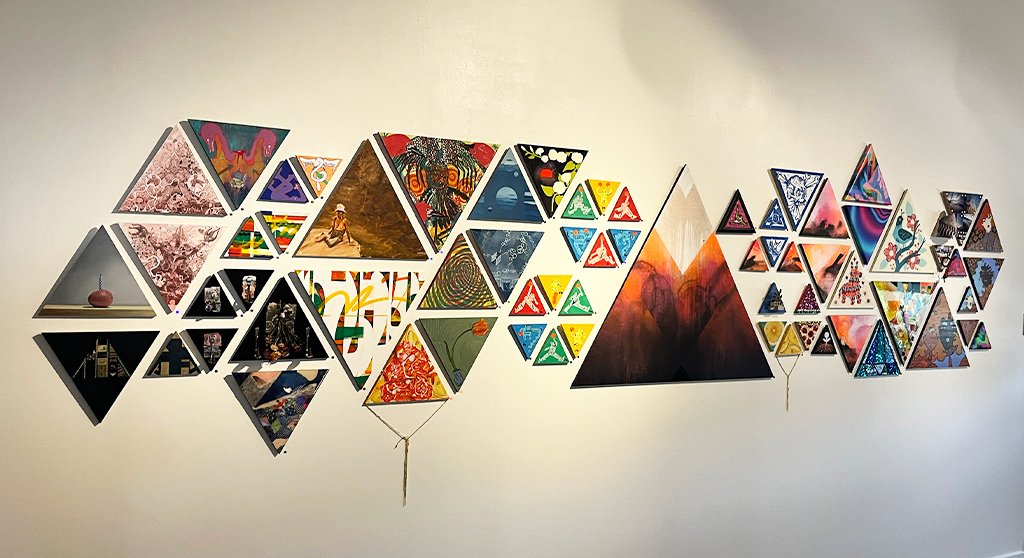A new method has been used to accurately date rock art found on the Indonesian island of Sulawesi which is now thought to be the oldest evidence of humans depicting interactions – or a “scene.”
Located in the limestone cave of Leang Karampuang in southern Sulawesi, the rock art depicts 3 human-like figures interacting with a wild pig. There is also an image of a type of antelope.
Results of the new dating method published in Nature reveal that the cave paintings are at least 51,200 years old – maybe even older. This makes the rock art the oldest reliably dated cave art image in the world and the earliest evidence of a narrative.
An international team of scientists including those from Australia and Indonesia used a novel technique to date tiny layers of calcium carbonate which has formed over the millennia on top of the artwork.
Previous methods could not account for the fact that this calcium carbonate doesn’t create uniform layers, but a complex “popcorn”-like pattern.
The new method, known as laser ablation U-series (LA-U) involves vaporising a tiny sample of the calcium carbonate with a laser. The sample is then analysed to determine the amount of uranium decay it has undergone to tell how old the layer is.
“We have previously used the uranium-series method to date very old rock art in two parts of Indonesia, Sulawesi and Borneo, but our new LA-U-series technique is more accurate,” says senior author Maxime Aubert, an archaeologist and geochemist from Griffith University. “It will revolutionise rock art dating.”
The technique “enables us to create detailed ‘maps’ of calcium carbonate layers,” corresponding author Renaud Joannes-Boyau from Southern Cross University.
First author Ahdi Oktaviana is a PhD candidate at Griffith University says the results are very surprising.
“None of the famous European Ice Age art is anywhere near as old as this, with the exception of some controversial finds in Spain, and this is the first-time rock art dates in Indonesia have ever been pushed beyond the 50,000-year mark,” Oktaviana says.
“It is noteworthy that the oldest cave art we have found in Sulawesi consists of recognisable scenes: that is, paintings that depict humans and animals interacting in such a way that we can infer the artist intended to communicate a narrative of some kind – a story,” adds co-author Adam Brumm, also an archaeologist at Griffith.
At another nearby cave, the researchers used the technique to revise the age of rock art, increasing its age by 4,000 years to at least 48,000 years old. Brumm says the people depicted in those caves, though essentially stick figures, are interpreted as therianthropes – part human, part animal beings. Therianthropes are relatively common in ancient art, but these are now the oldest reliably dated examples in rock art anywhere in the world.
Because the rock art is so much older than anything found in Australia, Maxime Aubert says it is hard to draw a link between the humans who made the Sulawesi paintings and ancient artists of Australia.
But it’s possible that future research may find a connection.
“Rock art is really hard to date,” Aubert says. “In Australia, there’s a lot of paintings, but most of it are not in limestone caves, they’re in sandstone. There are different types of coatings that form on top of it that aren’t applicable for uranium series dating. We think there could be a possibility in the future and we’re working on it at the moment.”
Indonesia thousands of years ago is believed to have been home to at least 3 other species of human including the “hobbit” (Homo floresiensis) and Denisovans,but the researchers say they’re reasonably sure that the Sulawesi cave art was produced by modern humans.
“We know that modern humans are capable of making rock art like this. But we do know that there were other human species in the region also at the same time. We know that from the DNA of modern people living in Papua today,” says Aubert.
The team say their new technique could be used to more accurately date rock art in other parts of the world.






